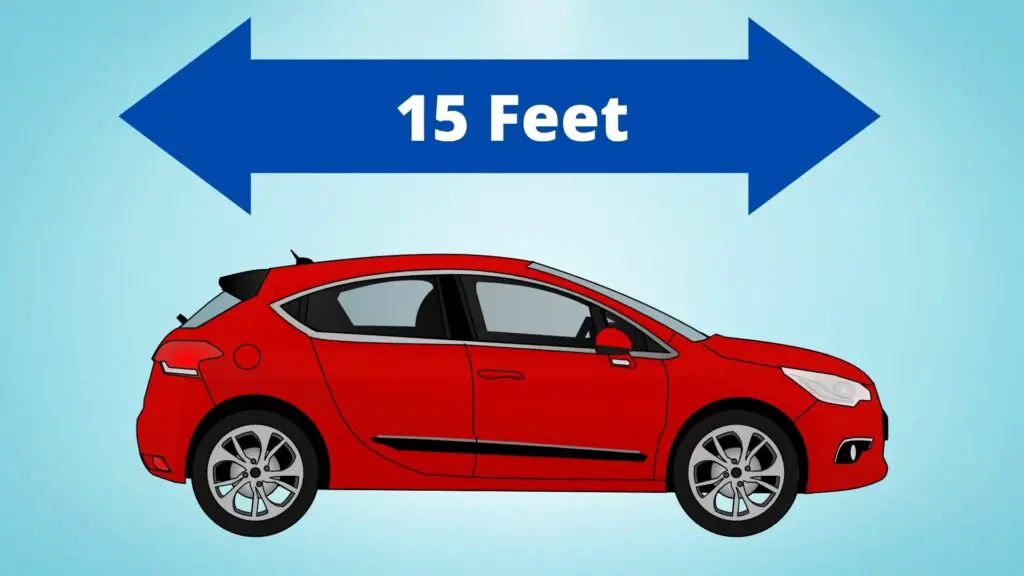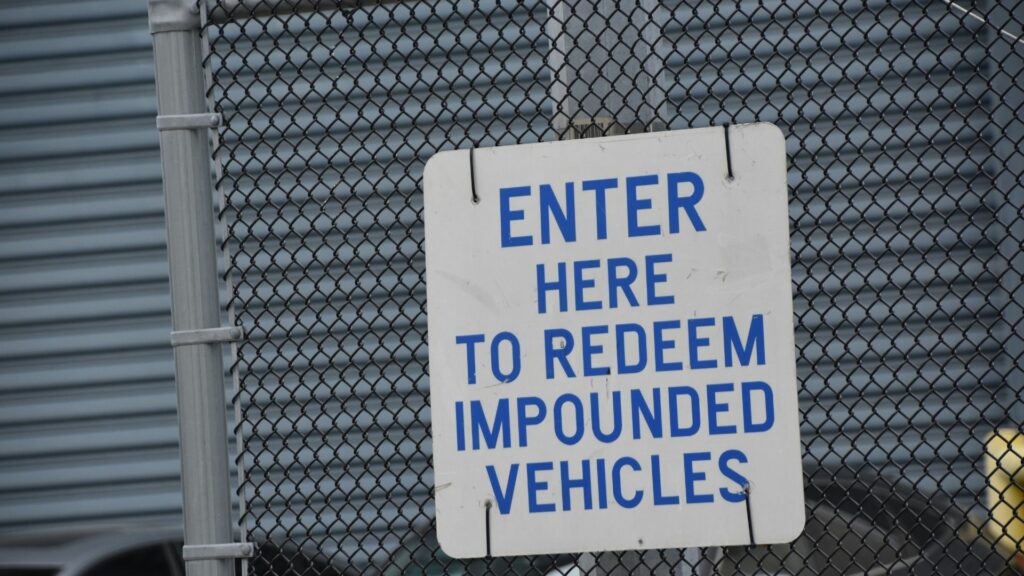When you park your car near a fire hydrant, it’s important to remember two things: first, always obey the posted restrictions; and second, never place your car directly in front of or next to the hydrant. Every city has laws regulating how far away you can park from a fire hydrant. The laws vary from one city/state to the next, but they usually fall within a small range. How many feet do you have to park away from a fire hydrant?
In most cities, you need to park at least 15 feet away from a fire hydrant, unless otherwise indicated by signage. It’s easy to visualize the distance since the average car is 15ft long. So you need to be just over 1 car length away from the hydrant.
Every driver knows that you can get a ticketed/towed for parking next to a fire hydrant, but it’s also an important safety issue. Firefighters need to access fire hydrants immediately in an emergency. A 2-3 minute delay to smash your windows and run a line through your car could mean the difference between life or death.
How Far Away Can You Park From A Fire Hydrant?

It’s no secret that parking close to a fire hydrant can get you in trouble. Most people know that can’t park in front of a fire hydrant, but how close is too close? And what are the consequences if you’re wrong?
Every city has laws regulating how far you need to park away from a fire hydrant. Most cities ban you from parking within 15 feet of a fire hydrant, but every city/state has different laws.
There may be exceptions to that rule in congested areas where it would be hard to access the hydrant. Make sure you check the nearby signage to get a clear indication of where you’re allowed to park.
We’ve all played the guessing game when thinking about parking next to a fire hydrant. What if I’m only parked there for a minute? Can I pull forward a few extra feet to squeeze in there? Will I get a ticket if I’m only a few feet inside the restricted area?
It can be tempting to push your luck next to a fire hydrant, but we’re not just talking about a parking fine and possible tow. Do you really want to be the guy that slows down a firefighter in an emergency and gets his windows smashed out? Don’t be that guy! Make sure you give firefighters plenty of room to work in an emergency.
Important Note: Some cities have different laws for commercial vehicles and tow trucks. Make sure you know the exact rules in your city before parking in restricted areas. Also, some fire hydrants are located underground and can’t be accessed from the street. Even if you can’t see the hydrant, you’ll still get a fine and they’ll have to tow your car away in an emergency.
Exceptions to the rule
- Driver Sitting In The Vehicle: In most municipalities, it’s generally OK to stop in front of a fire hydrant if you, as the driver, are staying in a running car and have the ability to quickly move the vehicle. The law usually states that somebody needs to be in the drivers seat, but you might not get ticketed if there’s a passenger in the car.
- Loading/Unloading Passengers: There may also be an exception for loading/unloading passengers. That only takes a minute or two and parking in front of a hydrant is better than blocking the road. You just need to be able to quickly move the vehicle in an emergency. Delivery drivers are constantly getting tickets for parking in front of hydrants for a minute and leaving their car to drop off the delivery.
- Additional Street Signs: You may also run into additional signage limiting where you’re allowed to park. If there isn’t a sign nearby, refer to the closest sign on the road. It doesn’t matter how far away the sign is. You can still get a ticket for a sign that’s located 1/2 mile away from your car.
How To Measure Your Car’s Distance From A Fire Hydrant

If you ever need to know how close you can park to a fire hydrant, there is a way to measure it. You can use a measuring tape, but most people don’t carry measuring tapes around in their car. So you will need to make a judgement call to figure out if you’re 15ft away from the hydrant.
Some cities have clear markings on the ground to tell you how far you need to be away from the hydrant. They paint the curb red or yellow to give a clear guideline on where you can park. There may also be signs nearby further limiting where you’re allowed to park. That’s common in narrow roads where firefighters have limited access to the hydrant.
Estimating your distance away from a fire hydrant is fairly simple. It might seem like 15ft is an arbitrary distance, but a lot of thought went into setting that length. That’s the average length of a car, so you can easily visualize how far away from the hydrant you need to be. Take a step away from your car and try to visualize if you can squeeze another car in the gap.
Parking enforcement officers can be ruthless about certain laws, but they usually let 2-3 ft slide. They make a judgement call on whether or not you’re close enough to have purposely ignored the law. The only exception is when there’s a clearly painted street curb or “No Parking” sign nearby. You will definitely get a ticket in those situations.
Parking Tickets and Tow/Impound Fees

Parking too close to a fire hydrant can result in hefty fines. Contact your local fire department for more information. If you get caught parking in restricted areas, you’ll be towed and charged with a ticket. Plan on spending at least $500 to get your car back if it gets towed. $150-$250 for the ticket and a $200-$300 for the impound.
There will be additional fees for every day your car stays at the impound lot. My car got towed on a street sweeping day when I was in college and I didn’t find out about it until I got home from class. The impound lot was closed by the time I realized my car was towed so I had to pay $150 more the following day.
The fines can quickly add up if you can’t pay immediately. I had a friend in college that had to give up his car to the tow company, because it wasn’t worth getting it out of the lot. It was an old beat up Chevy Cavalier and 2 days of fines was worth more than the car. Once the fines were worth more than the value of the car the police confiscated the vehicle to sell at a Sherrifs auction.
Firefighters Will Smash Your Car Windows To Access A Fire Hydrant

If you live in a city and see a fire truck speeding down the street, you can be sure that firefighters are rushing to extinguish a blaze. What you may not know is that they’re also racing to find a working fire hydrant. If you’re parked in front of a hydrant, they’ll break your car windows so they can run a hose through your car.
It may seem like an excessive measure, but it’s faster for firefighters to smash a window than try to locate and open a fire hydrant that’s further away. And since minutes count when fighting a fire, this extra step can mean the difference between life and death.
In non-emergency situations, they usually call in a tow truck to have your car ticketed and impounded. They have the rite to smash your window, but it’s not worth the bad PR of smashing a window for no reason.
5 Common Fire Hydrant Mistakes to Avoid at all Costs
You can be the nicest, most obedient person in the world, but nobodies perfect. Even if you try your best to follow every rule, it’s easy to get confused when searching for street parking. Laws vary from one city to the next and you can easily overlook important parking regulations. Here are the 5 most common fire hydrant mistakes that you need to avoid.
- Trusting A Poorly Written Sign: Don’t blindly trust every street sign that you see. Not following the signs will get you ticketed/towed, but you still need to follow laws that aren’t written on the sign. Just because a sign has an arrow indicating you can park past a certain point doesn’t, mean you can park close to a hydrant (stay 15ft away). These are extremely common near fire hydrants located at the ends of streets and near bus stops.
- Nearby Signs With Different Regulations: Every city has a set law in place regulating the distance you need to park away from a hydrant, but there’s always the stipulation unless otherwise indicated by signs. These signs are usually found near difficult to access a hydrants.
- Quickly Jumping Out Of Your Car: Most hydrant laws are written in simple terms. You need to be able to immediately get away from the hydrant in an emergency. That means your car needs to be running and there has to be somebody in the drivers seat. Jumping out of your car to run inside for a minute will result in a ticket. There may be an exception to that rule (depends on the city) if you’re assisting a disabled passenger exiting the vehicle.
- Underground Hydrants: It can be hard to spot an underground fire hydrant. These are common in older cities that haven’t upgraded their infrastructure to install modern above ground hydrants. They look like a typical round manhole cover (sometimes square) with a sign posted nearby.
- Broken Hydrants: It’s not your job to declare whether a fire hydrant is working or not. You can still get a ticket by parking next to a hydrant that’s clearly not functioning. Parking next to a hydrant that’s pulled out of the ground and laying on its side is exactly the same as parking next to a functioning hydrant.



